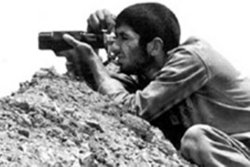 Rasa – A conference entitled, “The Media, Sacred Defence and Resistance” was held at the conference hall of the Directorate of the Ministry of Culture and Islamic Guidance of Qom Province.
Rasa – A conference entitled, “The Media, Sacred Defence and Resistance” was held at the conference hall of the Directorate of the Ministry of Culture and Islamic Guidance of Qom Province. RNA – A conference entitled, “The Media, Sacred Defence and Resistance” was held on May 22nd with the support of the Media Basij at the conference hall of the Directorate of the Ministry of Culture and Islamic Guidance of Qom Province.
Speaking at this media meeting, Sayyed Musa Hoseyni-Kashani, the head of the Directorate of Ministry of Culture and Islamic Guidance of Qom province, and Reza Rahimi-Tanha, Meysam Aghajanpour, and Ali Bitarafan, filmmakers on subject of the Sacred Defence [Iran-Iraq War], expressed their memories of the Sacred Defence era and the Defence of the Holy Shrines in Syria and Iraq.
Mr. Hoseyni-Kashani referred to the role of the media in promoting the culture of the Sacred Defence in his remarks and said, “Many young people have not understood the Sacred Defence era and therefore, the media must engage in strong efforts to increase the understanding of this era among the younger generation.”
Mr. Aghajanpour, the director of the documentary “For Nubl, For al-Zahra,” spoke about the background of the documentary, stated, “When the presence of the team of Martyr Mortaza Avini in the theatres of operations was announced during the Sacred Defence, a group of propagandists came but today it is seen that the films of this group are the best documents for promoting the culture of the Sacred Defence era.”
Mr. Bitarafan said that the Sacred Defence era has had a lot of bittersweet memories for the people of that era and added, “Today, the war is over, but the events of that era are supposed to be transmitted by cameras to generation today. In other words, today the camera can be likened to a weapon.”
Mr. Rahimi, a photographer during the Islamic Revolution and Sacred Defence eras, pointed to the hardships of filming and photography during the Sacred Defence, saying, “During the Sacred Defence, there were not enough facilities for photography or filming, but today there are many possibilities and they must be used appropriately.”
In conclusion, Reza Rahimi-Tanha, Ali Bitarafan, and Meysam Aghajanpour were appreciated as prominent filmmakers of the Sacred Defence era and the Defence of the Holy Shrines by the Media Basij and the Ministry of Culture and Islamic Guidance of Qom Province.
The Iran-Iraq War, called the “Sacred Defence” in Iran, was an armed conflict between Iran and Iraq, beginning on September 22nd, 1980, when Iraq invaded Iran, and ending on August 20, 1988, when Iran accepted the UN-brokered ceasefire.
Rasa News Agency
112/975